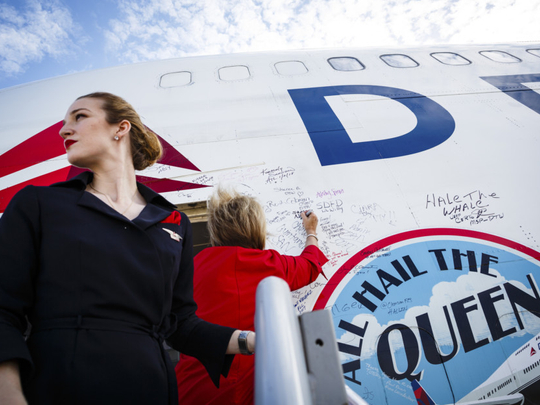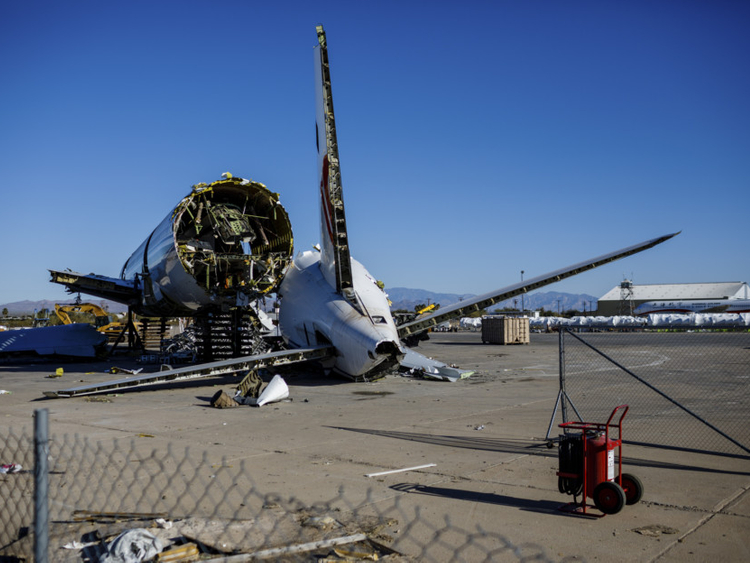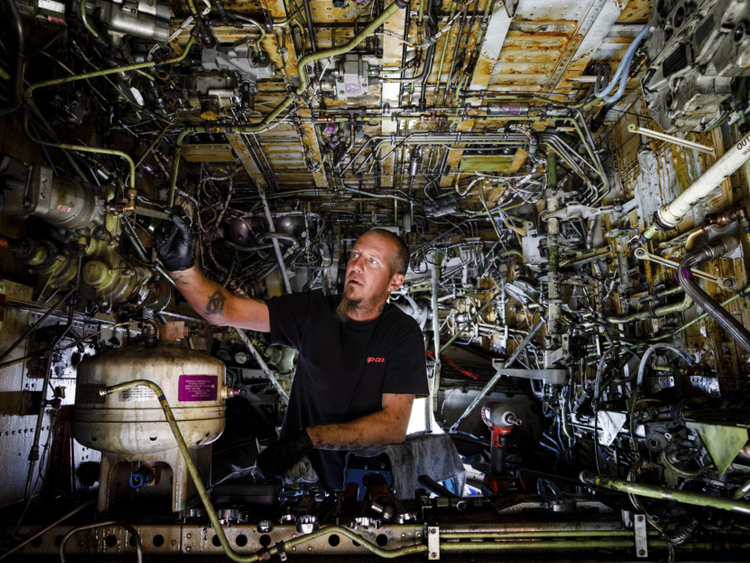
There may be no airliner as recognisable as the Boeing 747, the world’s first jumbo jet, with its iconic hump of an upper deck. For aviation fans, the introduction of the “Queen of the Skies” was a triumph of engineering and grace: unprecedented size and speed with spiral-staircase international glamour.
But the airline business has changed, and the giant plane has become more expensive to operate. A couple of weeks ago, the final 747 flight by any commercial US airline took to the sky. Like so many others before it, the plane was heading to the Southwest to retire.
A passer-by at Atlanta’s Hartsfield-Jackson International Airport might have noticed something unusual as Boeing 747 No. 6314 pushed back from the gate for the last time. Onlookers in the terminal waved farewell as the plane, operated by Delta Air Lines, taxied out to the runway. Undeterred by the chilly weather, even members of the ground crew pulled out their phones to memorialise this flight in photos.
On board was a small group of passengers — mostly Delta employees. Paul Gallaher was serving as first officer. Earlier in his career, as a pilot for Northwest Airlines, he had helped fly a fleet of brand-new Northwest 747s from Boeing to the airline’s home base in Minneapolis. Delta inherited those planes when the companies merged 10 years ago. Like No. 6314, he would retire when the flight touched down.
Back in the cabin, Gene Peterson, another Delta 747 captain, and Holly Rick, a flight attendant, had other plans. They had met when they were on a 747 charter flight crew in 2009. Now they prepared to walk down the aisle — not just to their seats, but to say “I do”. They did, somewhere over Memphis, Tennessee.
“I’m going to cry before today is over,” said Rebecca Johnson, one of the flight attendants on board. “It’s just part of aviation history. To be a part of it is kind of awe inspiring.”
Four hours after take-off, the jumbo jet was circling above cotton fields in Arizona’s Sonoran Desert, preparing to make its final approach to Pinal Airpark, where its next chapter would begin.
The 747 revolutionised the way people travelled when it began service in 1970. Mark Vanhoenacker, a pilot for British Airways and the author of “Skyfaring: A Journey With a Pilot,” wrote in “The New York Times” last year that the aircraft took advantage of economies of scale to make long-distance air travel affordable to the masses for the first time.
“This aircraft is a marvel for when it was built,” said Anthony Black, a Delta spokesman aboard the flight. But, he pointed out, a marvel of 1960s engineering is not necessarily suited to 2018 industry needs. Many airlines are moving to a business model that focuses on connecting more cities directly with smaller, more fuel-efficient planes, rather than funnelling passengers through a few large hubs.
The desert climate makes Pinal Airpark, between Phoenix and Tucson, an ideal place to store aeroplanes long term, and about 120 aircraft are here, scattered across the desert floor. The dry air prevents major corrosion, so their parts can be used to help keep other planes flying. Aeroplanes can even be kept in flying condition, ready to go back into service on short notice.
Brandi Lange is an operations manager for Logistic Air, one of the companies that own or maintain former airliners at Pinal Airpark. “My main thing here is parts and part support,” she said. Her company’s inventory includes two former Northwest Airlines cargo 747s and a passenger 747 that used to fly for Trans World Airlines, a brand that disappeared after it merged with American Airlines in 2001.
That TWA plane is one that Lange pays particular attention to. “I’m pretty sure it’s haunted,” she said. “I’ve gone in there before and there was a newspaper, and I’d move it and put it somewhere and the next thing I would know it would be right by the stairs. And I’d move it somewhere else and it would be right over here next to the stairs again.”
Though many of the plane’s valuable electrical components have been removed, whole seating sections are preserved — filled ashtrays (dating to at least 2000, when the US fully prohibited smoking on flights), old magazines, emergency oxygen masks and all — seemingly ready for passengers to board. The air in the cabin is still permeated by the musty, familiar aroma that greets travellers at the door to any plane waiting at the end of a jetway.
Even if an aeroplane has outlived its useful flying life, its components and metal from the fuselage can almost always find another application. Sometimes that might mean going to Hollywood: The new Fox TV show “LA to Vegas”, a comedy about the airline industry, got many of its aeroplane seats and other set pieces from Pinal Airpark. Jet Yard, another tenant at Pinal Airpark, focuses primarily on dismantling and scrapping planes that airlines no longer wish to fly.
The plane’s body can be melted down and reused in some other way. “Could be a pop can, could be a beer can, could be part of a car, could be part of another aeroplane,” or a mobile phone, said Pat Connell, general manager of Jet Yard. “There’s an uncountable amount of uses for the metal.”
But going to the desert doesn’t always mean an aeroplane will be broken apart and turned to scrap. “I would say close to half of the aircraft or more will get reintroduced into service at some point in time,” said David Querio, president of Marana Aerospace Solutions and Ascent Aviation Services.
His company, which also sometimes dismantles aircraft, is performing heavy maintenance on about 25 aeroplanes, and is storing more than 100 others at Pinal Airpark, including the 747 fleet that Delta just retired. Although the airline has not announced specific plans for those aircraft, Querio has seen similar planes become workhorses in other parts of the world.
For air carriers in Africa, Asia and South America, buying a used aircraft is “a lot more affordable than buying new aircraft,” he said. Even though they are less fuel efficient than modern planes, their higher operating cost is offset by the low purchase price, making second-hand jumbo jets an ideal choice for airlines looking to expand.
Pinal Airpark is sometimes called a graveyard or boneyard for planes. Jim Petty, the airpark’s manager, bristles at that description. “It’s really not what we are,” he said. “It’s a maintenance and storage facility.”
He’s trying to change that perception with informal tours and a visitor-friendly attitude. He wants to spread the word that planes here, in one way or another, almost always have more to come.
After 747 No. 6314 landed, and after the passengers (including the two newly-weds) and crew had left, the inside of the giant plane was suddenly empty and utterly quiet, the unoccupied seats and aisles illuminated only by the sunlight filtering through the windows. Sitting in the desert, the Queen of the Skies still looked regal in this new realm.
— New York Times News Service














